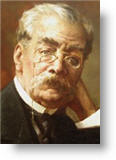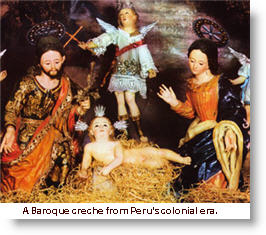The following story was first translated into English in 1934 and published in The West Coast Leader that December. It is one of the “Traditions” by Ricardo Palma (1833-1919), who mixed history and hearsay to chronicle life in Peru across several centuries, particularly the colonial and republican eras.
 — Away back in the days of the monarchy, Yuletide in Pizarro’s city was the best of all that is good. It was the season of the year most wholly given up to wine and revelry. From the fifteenth of December commenced the special morning masses. And what a crowd of youth and dandyism assembled in the churches to be tempted by and ready to fall in love with the nearest sweetheart!
— Away back in the days of the monarchy, Yuletide in Pizarro’s city was the best of all that is good. It was the season of the year most wholly given up to wine and revelry. From the fifteenth of December commenced the special morning masses. And what a crowd of youth and dandyism assembled in the churches to be tempted by and ready to fall in love with the nearest sweetheart!
A creole orchestra composed of lusty singers and songstresses rendered a program of all the popular airs of the day, including that great favorite
Sweetest Santa Rosa,
It’s all very fine and dandy;
But how comes it you let them impose a
Tax upon our brandy?
(Santa Rosa de Lima, ¿Cómo concientes que un impuesto le ponga al aguardiente?)
The religious and the sacred did not exclude the worldly and the profane. At the end of Mass a group of demoiselles used to dance the ‘cachua’ and the ‘maisillo’ to the accompaniment of couplets not always the most orthodox.
The masses lasted a couple of hours or so, from seven to nine. They were rich in good things and had none of the insipidity of those of the present times. Today, at our Yuletide and Christmas Eve masses there are no whistles, canaries, flutes, mandolines, rattles, drums, singing and dancing. The lads don’t bray like donkeys or crow like cocks, bark like dogs, moo like cows or meaow like cats. Christmas celebrations of today are but a pallid reflection of those in our colonial past.
Christmas Eve with its Midnight Mass was even more creole than the most creole. From five o’clock on the evening of December 24th, the four sides of the Plaza de Armas were laid out with tables on which were displayed flowers, sweets, preserves, toys, cakes, liquors and everything succulent that it has pleased the good God to create.
At midnight only the common people remained in the Plaza, pouring down drink after drink. The aristocracy and the middle classes wended their way to the churches where lasses sang from the atrium carols such as this:
Gee up, little donkey,
Let’s ride to Bethlehem,
For there a Child is born
For the good of men.
Gee ‘up, little donkey,
We’ll go to Bethlehem.
Tomorrow is a holiday
And the next day is the same.
In every home on the conclusion of Midnight Mass, the ‘tamales’ were the traditional dish. And since it was considered unhealthy to throw oneself into the arms of Morpheus immediately after a huge supper, they were washed down with the good red wine, of Cataluña, fiery sherry, sweet Málaga and riotous ‘sorrow breakers’ (pisco); dancing was indulged in until the first rays of the sun called a halt.
Insofar as the common people were concerned, not to be outdone by their betters, they caroused till daybreak around the fountain in the Plaza de Armas, with couples twisting themselves out of gear in dancing the ‘zamacueca’ — not the common-or-garden ‘zamacueca’ but one enough to awaken the dead.
 Side by side with the altars to the Virgin, which had been erected in all homes since the Feast of the Conception on December 8th, the Manger began to be installed as Christmas grew near, a minute stage showing the Stable of Bethlehem and all the legendary figures of the Bible story. Between seven and eleven on Christmas Eve, every family was at home to receive friends who came to admire and possibly criticize the Manger. Every visitor was welcomed with a glass of chicha or orgeat, these drinks being baptized with the none too proper name of ‘Orines del Niño’. In not a few cases after eleven when all but the most intimate friends had left, it was customary to indulge in the beating of toy drums and tin cans, while drink followed hard on the heel of drink.
Side by side with the altars to the Virgin, which had been erected in all homes since the Feast of the Conception on December 8th, the Manger began to be installed as Christmas grew near, a minute stage showing the Stable of Bethlehem and all the legendary figures of the Bible story. Between seven and eleven on Christmas Eve, every family was at home to receive friends who came to admire and possibly criticize the Manger. Every visitor was welcomed with a glass of chicha or orgeat, these drinks being baptized with the none too proper name of ‘Orines del Niño’. In not a few cases after eleven when all but the most intimate friends had left, it was customary to indulge in the beating of toy drums and tin cans, while drink followed hard on the heel of drink.
The most famous of all the Mangers erected in Lima was that shown in the monastery of the Bethlehemites or the Bearded monks (from whom the street Barbones* has been named). It was notable for the number of automatic dolls which were staged around the Cradle and for the carol-singing in honour of the Holy Child.
But, as every good thing has its end, on the Feast of the Magi (Twelfth Night) the Mangers were dismantled until another year. That night saw revelry at its pinnacle. And then once more the world settled down to wait for the dawn of another Christmas, with the same rejoicings repeated without the slightest variation from the traditions of the past.
*Barbones is the 15th block of what is now Jiron Junín, east of downtown where the city wall once stood in the Barrios Altos.





